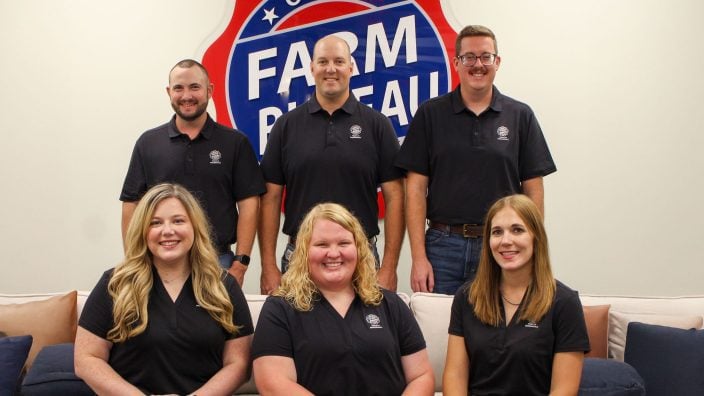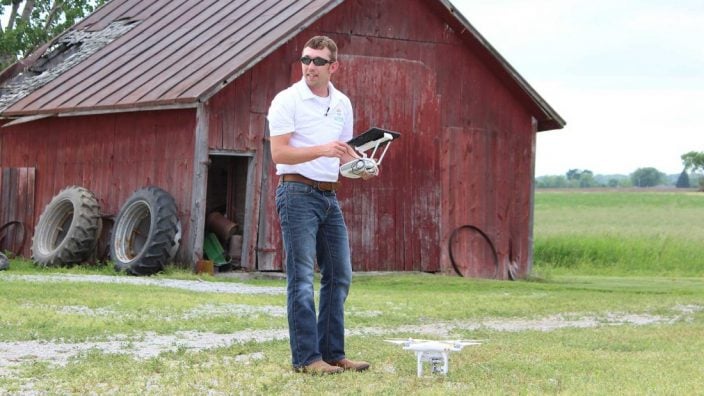Growing our Generation: Golden Owl Award
March is National Agriculture Month and in today’s world, agricultural education and awareness is needed more than ever. Hear from two of Ohio’s top ag educators.
Read MoreGrowing our Generation enewsletter features insights and ideas directly from Ohio’s young farmers and food and agricultural professionals. Sign up to get this e-letter sent directly to your inbox once a month.
The world of agriculture is always evolving. Keeping up with technology can be an important part of maintaining efficiency in your operations. Hear from Austin Heil, a Hardin County farmer, on how implementing new technology has improved his sixth generation family farm.
My background
During the day I am Precision Technical Support Specialist for Case New Holland, serving our dealer network in the U.S. and Canada. We diagnose and troubleshoot technical concerns on both the Case IH AFS (Advanced Farming Systems) and New Holland Precision Land Management solutions. After a few years of living in Pennsylvania working for CNH for the Flagship Field Test group, I moved back to the family farm to start farming with my dad.
One day, I asked my dad why the neighbor’s corn always looked better than ours and that one question drastically changed how I looked at production agriculture and I knew I wanted to get more involved.
I started Homestead Precision Farming to collaborate with growers and assist them in finding solutions driven by data that will work on their farm. We have found ways to adapt technology to just about every pass we make across the field. Our starting point was adding a Precision Planting 20/20 monitor to our six-row planter. After that first season with the monitor, we quickly observed that one of the keys to raising a great crop was making sure that every seed was placed perfectly. We purchased an older John Deere Vacuum Planter and upgraded it to hydraulic downforce and electric drives. It goes back to the saying “You can’t manage what you can’t measure.” We then started grouping the variables on our operation into 1.) What we can control, 2). What we can’t control and 3.) How can we influence what we can’t control?
Based on the data collected from the 20/20 with the new planter, we were confident we solved our emergence issue. Another form of technology we utilize are drones.
What can drones do for agriculture?
 Drones are able to provide us with a high-resolution image of the field. It is like capturing an MRI because with one flight over the field, the data is able to provide us with many layers of information. A basic satellite image in Climate Fieldview is going to break the field down into three management zones. It allows me to quickly map a 100 acre field and instantly provide an orthomosaic (a distortion-free map) in high resolution so that I can see row by row details.
Drones are able to provide us with a high-resolution image of the field. It is like capturing an MRI because with one flight over the field, the data is able to provide us with many layers of information. A basic satellite image in Climate Fieldview is going to break the field down into three management zones. It allows me to quickly map a 100 acre field and instantly provide an orthomosaic (a distortion-free map) in high resolution so that I can see row by row details.
We installed a yield monitor on our 1979 L2 Gleaner combine to help us understand the amount of bushels that we are harvesting to help us tailor our precision soil sampling program, however the yield map is not able to show any insight on why that area of the field had a high or low yield. The drone is able to tie all the data together from soil sampling, elevation, planting information, and yield maps.
Next will be utilizing this technology for crop protection applications. In the past we utilized aerial applicators using an AirTractor 802 to fly fungicide on the corn. This year we partnered with another farmer who utilized a DJI T40 spray drone. The neighbor used the traditional aerial applicator so we are looking forward to seeing the results from each type.
What are some challenges you face with drone technology?
Just like any technology, the price to enter can be that first hurdle for many. The next step is to determine if you are just going to fly for aerial photos or for spraying. The Ohio Department of Agriculture has a great resource if you want to utilize aerial pesticide application.
One of the limiting factors is the same challenge that electrical automobiles have with battery technology. When I first started flying we had 8-10 minutes of flight time carrying just a GoPro. We now have QuadCopters that will fly 45 minutes to an hour. As battery technology improves, the use of drones for farm use will increase.
There is no cookie cutter approach that is going to work every time on every farm. Find one new thing to try every year. Find a team of trusted advisors that you can bounce ideas off of when looking to adapt new technology on your farm. Precision Planting has a Precision Technical Institute where they research different ways to improve yield and profitability. I see the future of agriculture facing many regulatory and labor issues. There are fewer agriculturalists coming from the farm. We will need to find ways to be even more efficient on how we raise a crop. Technology is going to be the tool that allows us to measure what we are doing so that we are better able to manage it.
Ohio Farm Bureau Podcast featuring Kevin Morris, the Federal Aviation Administration’s “Drone Guy”
Tech at Farm Science Review

A great way to see the latest and greatest agricultural technology is at the 2024 Farm Science Review. It will be held Sept. 17-19 at the Molly Caren Agricultural Center in Madison County. If you find yourself near the corner of Beef Street and Friday Avenue, stop in at the Ohio Farm Bureau booth to visit with staff experts or renew your membership! Anyone who renews or purchases a new membership at Farm Science Review will receive a custom Ohio Farm Bureau metal sign, while supplies last.
Innovations in Ag Protection Final Webinar Aug. 30
Young Ag Professionals Hosts: Kayla & Luke Durbin
Engage with an innovative outreach campaign intended to reduce the number of accidents on ATVs and UTVs with Emily Atwood, manager of risk management consulting with Nationwide Agribusiness.
Upcoming Deadlines and Events


March is National Agriculture Month and in today’s world, agricultural education and awareness is needed more than ever. Hear from two of Ohio’s top ag educators.
Read More

Growing our Generation enewsletter features insights and ideas directly from Ohio’s young farmers and food and agricultural professionals. Sign up…
Read More

Dr. Ron Hanson helps counsel farm families to resolve conflicts while helping the next generation assure their financial future. He is a featured speaker at the 2025 Winter Leadership Experience.
Read More

The people you will meet, the experiences you gain will guide you for years to come, and the knowledge learned and networking will help you lead boards and communities.
Read More

State Committee members assist with creating educational and leadership development programs for Ohio Farm Bureau’s Young Agricultural Professionals, specifically the Winter Leadership Experience, each year.
Read More

Bethany Schappacher, a Clinton County Farm Bureau member, and her family own Schappacher Farms, a 50-acre pumpkin farm featuring a corn maze, hayrides, fall treats and other family activities.
Read More

Meet Abby Campbell, Sara Tallmadge, and Catherine Wolcott – Ohio’s Young Ag Professionals contestants who will compete at the American Farm Bureau Annual Convention in San Antonio.
Read More

Growing our Generation enewsletter features insights and ideas directly from Ohio’s young farmers and food and agricultural professionals. Sign up…
Read More

This year, the Land and Living Exhibit will be merging with the Little Farmers Exhibit to ensure that Ohio Farm Bureau and agriculture still have a presence outside of the livestock barns.
Read More

Allowing people a sneak-peek into our farm is a way to break negative stigmas. ~ Mackenzie Deetz
Read More